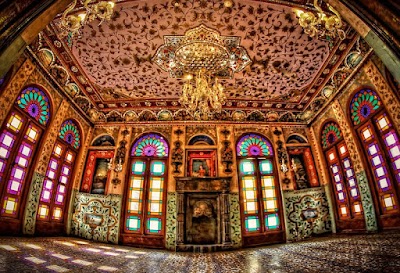Arak Grand Mosque (مسجد جامع اراک)
Overview
Introduction to Arak Grand Mosque
Nestled in the heart of Markazi Province, the Arak Grand Mosque (مسجد جامع اراک) stands as a stunning testament to Islamic architecture and cultural heritage in Iran. This magnificent mosque, also known as the Jameh Mosque of Arak, is a captivating destination for travelers seeking to explore the spiritual and historical richness of the region. Built during the Qajar dynasty in the late 19th century, it reflects a blend of Persian architectural styles while serving as a vibrant center for the local Muslim community.
As you approach the mosque, you’ll be greeted by its imposing facade, which features intricate tile work and elegant arches that invite you to explore further. The mosque's grand entrance is adorned with detailed carvings and geometric patterns, typical of Islamic artistry, making it a perfect spot for photography enthusiasts. Once inside, visitors are welcomed by a vast prayer hall, which can accommodate thousands of worshippers. The serene atmosphere, combined with the gentle play of light filtering through the stained glass windows, creates a spiritual ambiance that captivates all who enter.
Architectural Marvels and Features
The Arak Grand Mosque showcases a remarkable blend of architectural elements, including high vaulted ceilings, expansive courtyards, and a stunning minaret that rises majestically above the city skyline. The mosque's unique design incorporates both traditional Persian motifs and modern influences, making it a fascinating subject for those interested in architecture and history.
One of the standout features of the mosque is its stunning dome, which is adorned with colorful tiles that shimmer in the sunlight. The intricate calligraphy and floral patterns that decorate both the interior and exterior walls tell stories of faith and devotion, inviting visitors to appreciate the artistry and craftsmanship of the builders. As you wander through the mosque's various sections, take a moment to observe the subtle details, from the meticulously crafted woodwork to the elaborate mosaics, which reflect the deep cultural roots of the region.
Cultural Significance and Local Life
The Arak Grand Mosque is not just a place of worship; it is a living symbol of the community's identity and heritage. The mosque hosts regular prayers, religious ceremonies, and cultural events that draw locals and visitors alike. If you have the opportunity to visit during a prayer time or a special occasion, you will witness the deep sense of community and devotion among the worshippers.
Engaging with the locals can provide valuable insights into the customs and traditions of Iranian Islam. The mosque serves as a social hub where community members gather, discuss daily life, and share their experiences. This atmosphere of warmth and hospitality is a hallmark of Iranian culture, making your visit even more enriching. Don't hesitate to strike up a conversation with locals; they often take pride in sharing stories about their heritage and the significance of the mosque in their lives.
Visiting Tips
For foreign travelers planning a visit to the Arak Grand Mosque, there are a few tips to keep in mind. First, dress modestly, respecting local customs and traditions. Women should wear a headscarf and loose-fitting clothing, while men should avoid shorts and sleeveless shirts.
Additionally, it’s advisable to visit during weekdays when the mosque is less crowded, allowing for a more contemplative experience. Guided tours are available and can enhance your understanding of the mosque's history and significance. Lastly, take the time to explore the surrounding area, where you can find quaint shops and cafes offering a taste of local cuisine, allowing you to immerse yourself fully in the vibrant culture of Arak.
In summary, the Arak Grand Mosque is not only a masterpiece of architectural beauty but also a vital part of the community's spiritual and cultural life. A visit to this iconic landmark promises to be a memorable experience, leaving you with a deeper appreciation of Iran's rich heritage.



